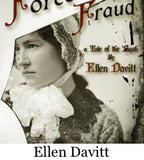Ellen Davitt
 Clan Destine Press - along with award-winning writer and self-confessed 'literary archaeologist' Dr Lucy Sussex - is proud to republish Australia's first murder mystery: Ellen Davitt's 1865 novel, Force and Fraud.
Clan Destine Press - along with award-winning writer and self-confessed 'literary archaeologist' Dr Lucy Sussex - is proud to republish Australia's first murder mystery: Ellen Davitt's 1865 novel, Force and Fraud.
Dr Sussex is credited with rediscovering with republishing the work of two 19th century Australian crime writers: Mary Fortune and Ellen Davitt.
Clan Destine's eBook edition of Force and Fraud — with an introduction by Dr Sussex — also includes a bonus short story, "The Higlanders Revenge".
Ellen Davitt — educator, artist, writer
Born in England, exact date unknown but baptised at Holy Trinity, Hull, on 4 March 1812, Ellen Heseltine was the eldest of five daughters. Growing up in a family with a high regard for the intellect, Ellen probably received a better education than most girls of her era. Certainly the family valued reading.
Ellen married Arthur Davitt in 1847 and the couple migrated to Australia in 1853 to take up the positions of Principal and Superintendent for the new Model School in East Melbourne.
In the Victorian era world-view, men dominated the public sphere and women controlled the private and domestic. Ellen Davitt transgressed these boundaries. She was a woman prominent in public life; as Superintendent she was in control of all the female pupils in the school. The position was subordinate to her husband the Principal, but the Davitts were a team — Arthur’s letters to the Board frequently included the phrase 'Mrs Davitt and myself'. Thus, while Ellen was a loyal wife, she was not in the background; she had opinions and was ready to express them.
The couple gained an entry in the Australian Dictionary of Biography, but with the notable omissions that Ellen was also a writer and exhibited artist.
After their dismissal from the Model School in 1859, Ellen opened the grandly-titled Ladies’ Institute of Victoria. This private school, in Carlton, was advertised in Melbourne papers as 'open for boarders and day pupils, and also offering evening classes, training for governesses'.
Arthur Davitt, who had long suffered from tuberculosis, retreated to Geelong for the sea air, where he died on 24 January 1860.
Ellen took up public speaking in 1861, with lectures on wide-ranging topics such as: The Rise and Progress of the Fine Arts in Spain; The Influence of Art; Colonisation v. Convictism; and The Vixens of Shakespeare.
It was clear, Dr Sussex says, that Ellen Davitt was "positioning herself as what we would now term 'a public intellectual,' an extraordinary undertaking at the time - given her gender, the contemporary bias against women orators, and the frontier society of colonial Australia."
Because of Australia’s origins as a penal colony, crime figured in our literature from the beginning. According to Dr Sussex though, "Generic crime fiction form, as found in Force and Fraud, came later. Content and form only began to coalesce in the 1850s — the era of the often lawless goldrushes — when interest in Australia was intense."
It's not known when Ellen actually began writing, but her first publication was the, as yet, untraced story 'Edith Travers'.
Force and Fraud - a genuinely original novel, well ahead of its time and literary context - was the lead serial in the first issue of the Australian Journal: a Weekly Record of Literature, Science and the Arts (2 Sept. 1865). The magazine was closely modelled on the London Journal, also a fiction magazine, but with a difference: its major subject matter was crime. As such, it reflected not only a national preoccupation, but also the experience of the first editor, George Arthur Walstab, a former policeman.
Accodring to Dr Sussex, the fact that Force and Fraud opened this new venture indicates that Ellen Davitt was a staff and star writer.
"Consequently the Australian Journal worked her into the ground. The novel was followed by two more, and a novella, all published in the first year of the journal. This formidable output meant quantity over quality. Only the debut is republishable." Dr Sussex says, "Force and Fraud, [is] a unique and accomplished early Australian murder mystery. The Davitt awards, now given annually by Sisters in Crime Australia for the best in published Australian women’s crime writing, is rightly named after her, for she was a significant pioneer of the genre."
Force and Fraud tells the story of a young artist accuses of murdering his fiance's father who objected to their match.
The narrative begins with a murder, includes a romance, and ends with the solution. Dr Sussex says: "Modern readers will note that it lacks a hero-investigator, but at the time that narrative mode had not gained genre dominance. An alternative model equally existed, splitting the role of detective among various characters: it can be seen in works such as Wilkie Collins’ 1860 The Woman in White, and even as late as Fergus Hume’s 1886 The Mystery of a Hansom Cab, the best selling detective novel of the 1800s.
"In Force and Fraud, the investigators include a lawyer, the feisty heroine Flora, and a Scottish shepherd. But there is equally a cast of those seeking to obstruct justice, impede the investigation."

